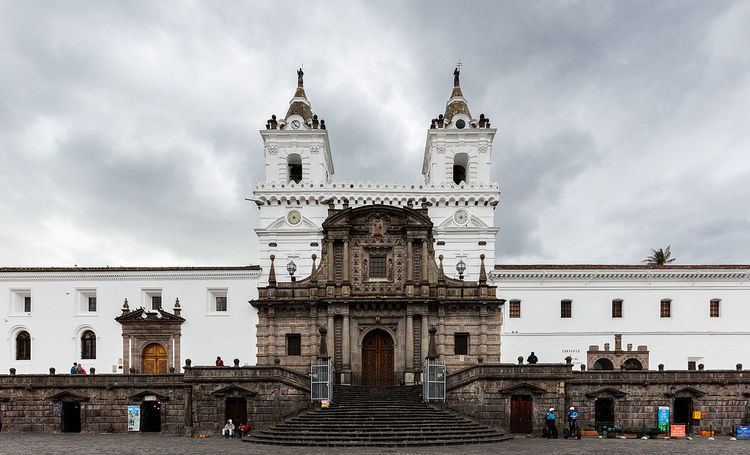Location Quito, Ecuador Rite Roman Rite Direction of façade Southeast Phone +593 99 277 7487 Groundbreaking 1534 | Affiliation Roman Catholic Completed 1604 Opened 1604 Architectural type Church | |
 | ||
Address Cuenca 477, Quito 170401, Ecuador Province Roman Catholic Archdiocese of Quito Similar Compañía de Jesús - Quito, La Capilla del Hombre, Intiñan Solar Museum, Ciudad Mitad del Mundo, Plaza de la Independencia | ||
The Church and Monastery of St. Francis (Spanish: Iglesia y Monasterio de San Francisco), commonly known as el San Francisco, is a 16th-century Roman Catholic complex in Quito, Ecuador. It fronts onto its namesake Plaza de San Francisco. The imposing structure has the distinction of being the largest architectural ensemble among the historical structures of colonial Latin America and for this reason is sometimes known as "El Escorial of the New World". The style evolved over almost 150 years of construction (1534-1680) through earthquakes and changes in artistic fashion. The Church houses the city's beloved Virgin of Quito (1734).
Contents
Layout
The San Francisco de Quito convent defined itself in its relations with the outside world according to three spaces:
Together, Church and Convent encompass three hectares including 13 cloisters (six of them major), three churches, and a large courtyard. In total, about 40,000 square meters of construction. San Francisco follows the classical typology of medieval monasteries. The main Church is the guiding axis and from there the cloister galleries extend: the refectory, the chapterhouse, and winery. These define a quadrangular courtyard, with the four respective pandas, or galleries: that of the chapter room, the refectory, the converts, and the mandatum. In addition to the basic dependencies of a convent, there were areas devoted to health care, education, crafts, a garden, and even a jail (to maintain strict discipline). The kitchen and dispensery operated in the cloister of services.
Style
The facade of the main Church reflects, for the first time in South America, Mannerist elements, which later became a reference point for that style in the rest of the continent. The severity of the building's Renaissance and Mannerist exterior contrasts with the inner decoration of the Church, in which Mudejar and Baroque elements bathe the nave, chapels, and high altar in an exotic golden splendour. In its nave and aisles, the Church of San Francisco reveals its Mudejar (Moorish) coffered ceilings, lavishly decorated altarpieces, and columns fashoned in different styles. In the choir — original from the end of the 16th century — Mudejar details are fully preserved, although the central nave was brought down by an earthquake and then replaced by a Baroque coffered ceiling in 1770.
Holdings
San Francisco houses over 3,500 works of colonial art, of varied artistic styles and techniques, most notably those of the famous Quito School of art, which had it genesis precisely here. Undoubtedly the most celebrated of these is the 18th century sculpture known as the Virgin of Quito, which has long been a kind of icon of the city. Here also is a magnificent Franciscan library, described in the 17th century as the best of the Viceroyalty of Peru.
History
Construction of the building began a few weeks after the founding of the city in 1534 and ended in 1604. The founder of the church was Franciscan missionary Jodoco Ricke. The building's construction began around 1550, sixteen years after Quito was founded by Spanish conquistadors, and was finished in approximately 1680. The building was officially inaugurated in 1605. The main cloister was added in 1605. In fact the original smaller church constructed in the sixteenth century was reoriented and dramatically expanded in the early seventeenth century, at which time the imposing facade that we see today was added.
With the support of European Franciscans, the Flemish Friar Joost de Rijcke, known in Spanish as Jodoco Ricke and Friar Pedro Gosseal – who came to the city two years after its founding – acquired land to the west side of the city's main plaza. This plot was where the palace of the Incan ruler Atahualpa (1497-1533) had once stood. In addition to being a market center for indigenous Ecuadorians, it was also the location of the military seats of the chiefs of the indigenous armies. All told, the place had enormous strategic and historical significance for the indigenous people the Franciscans wanted to evangelize.
It is not known who designed the original plans for the complex, though the most-accepted theory is that they were sent from Spain, based on the topographical study of Ricke and Gosseal. It is also possible that architects came from Spain for the construction of the monastery, or that Ricke and Gosseal managed the entire construction.
The Church underwent a major (US$2M) interior renovation between 2000 and 2010.
